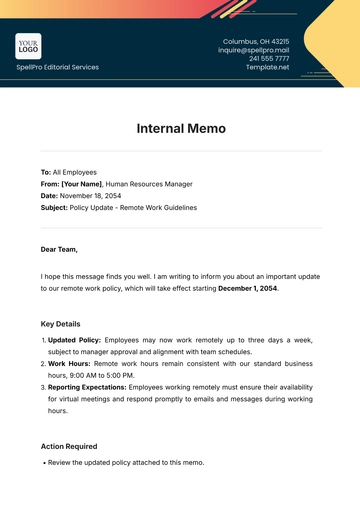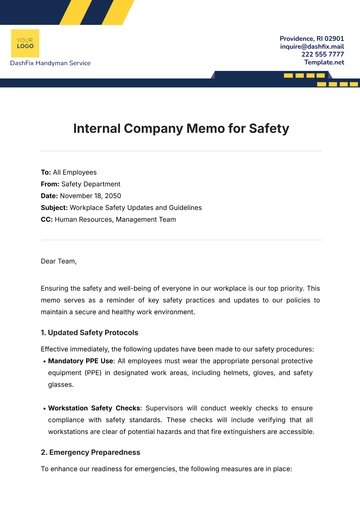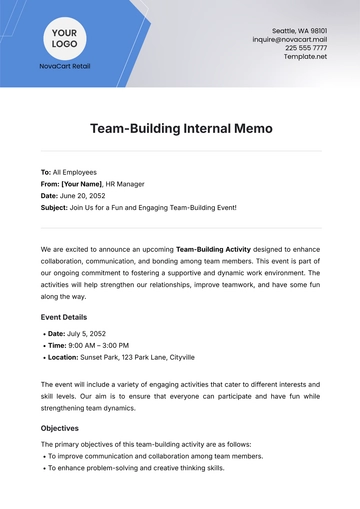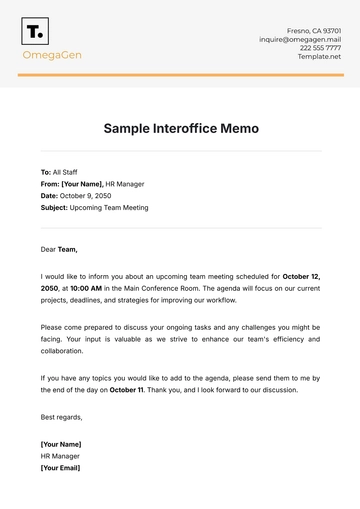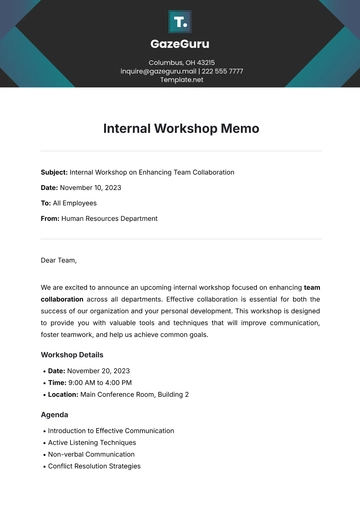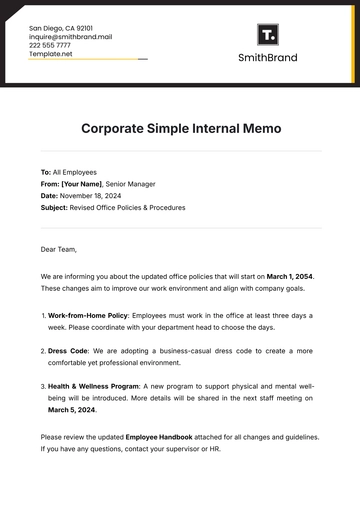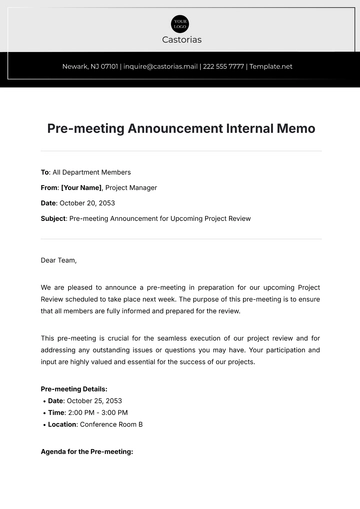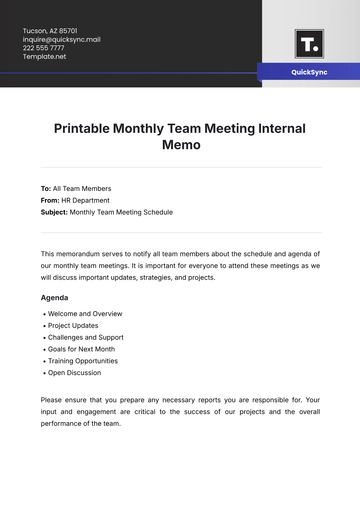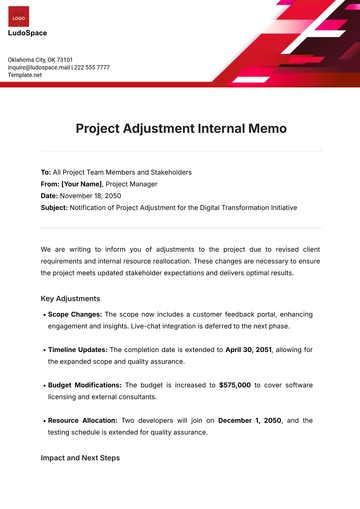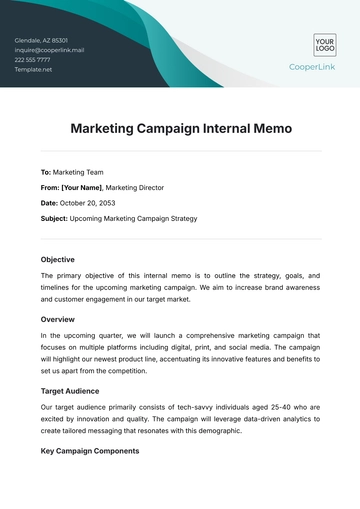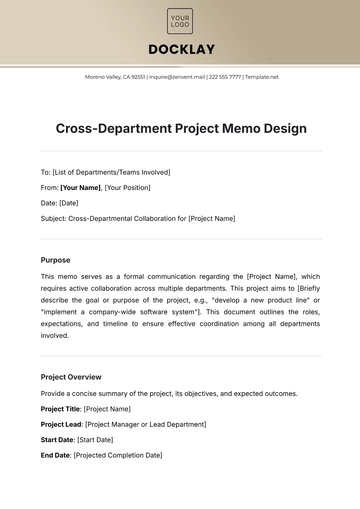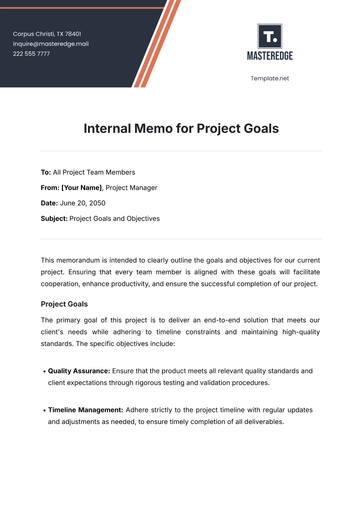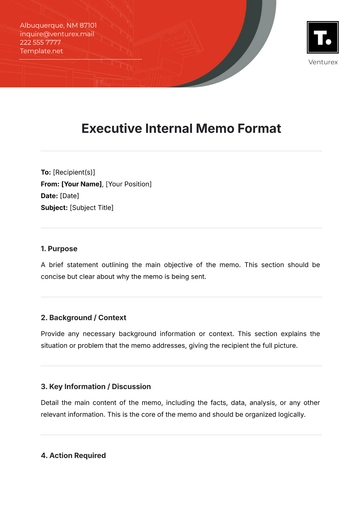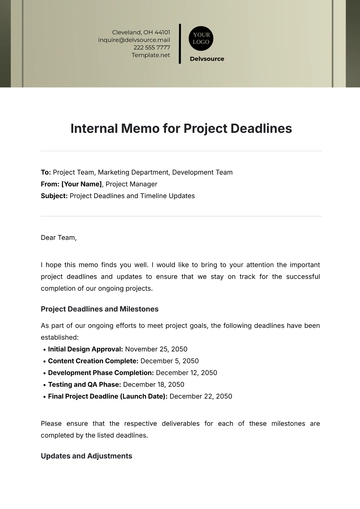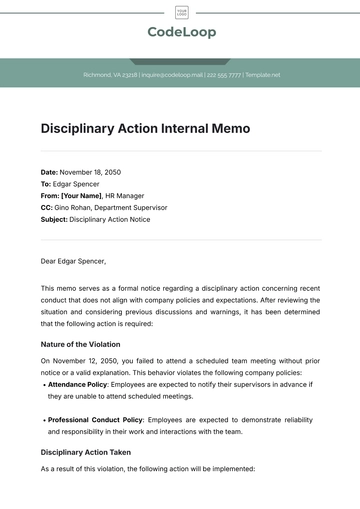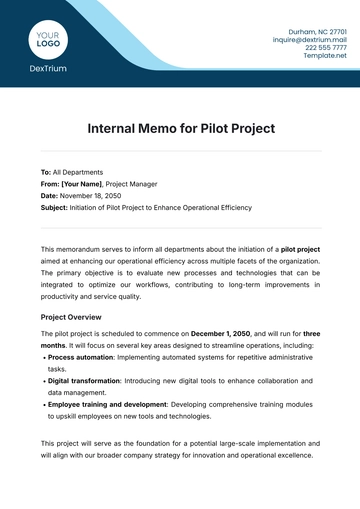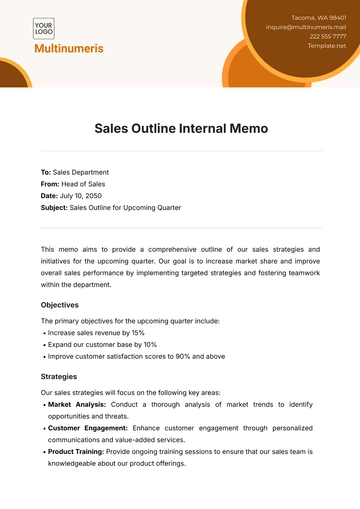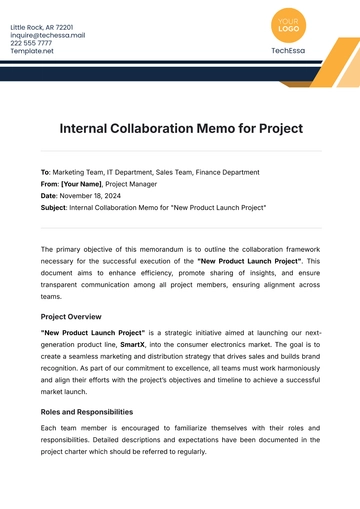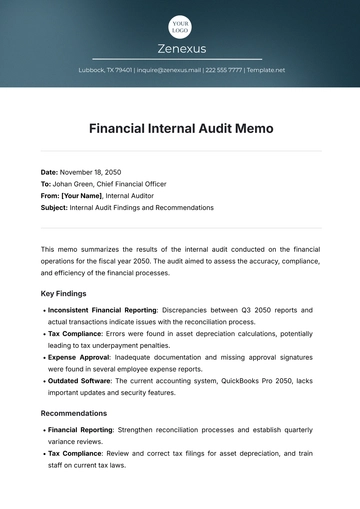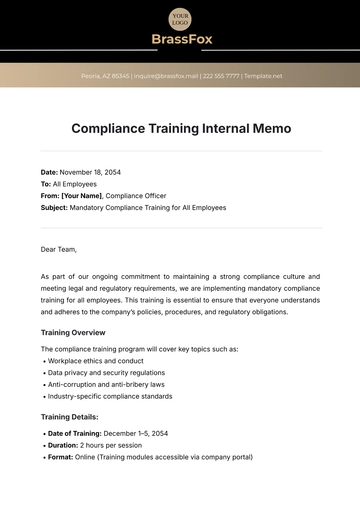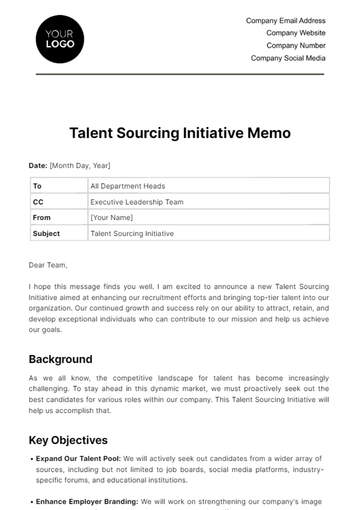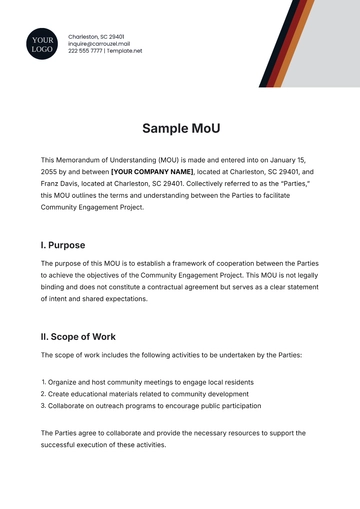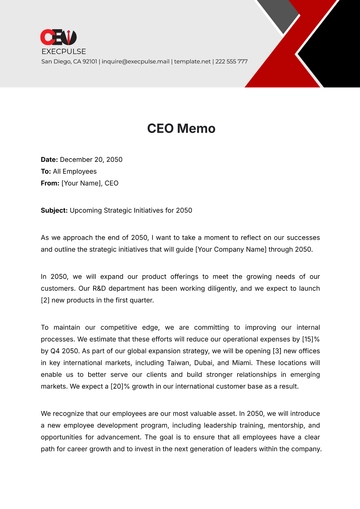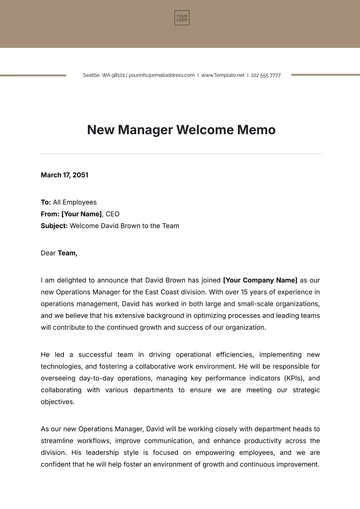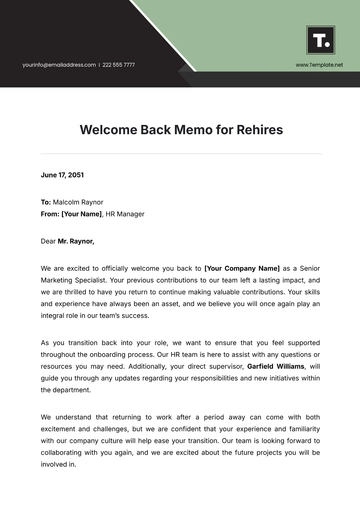Free Restaurant Strategy Memo
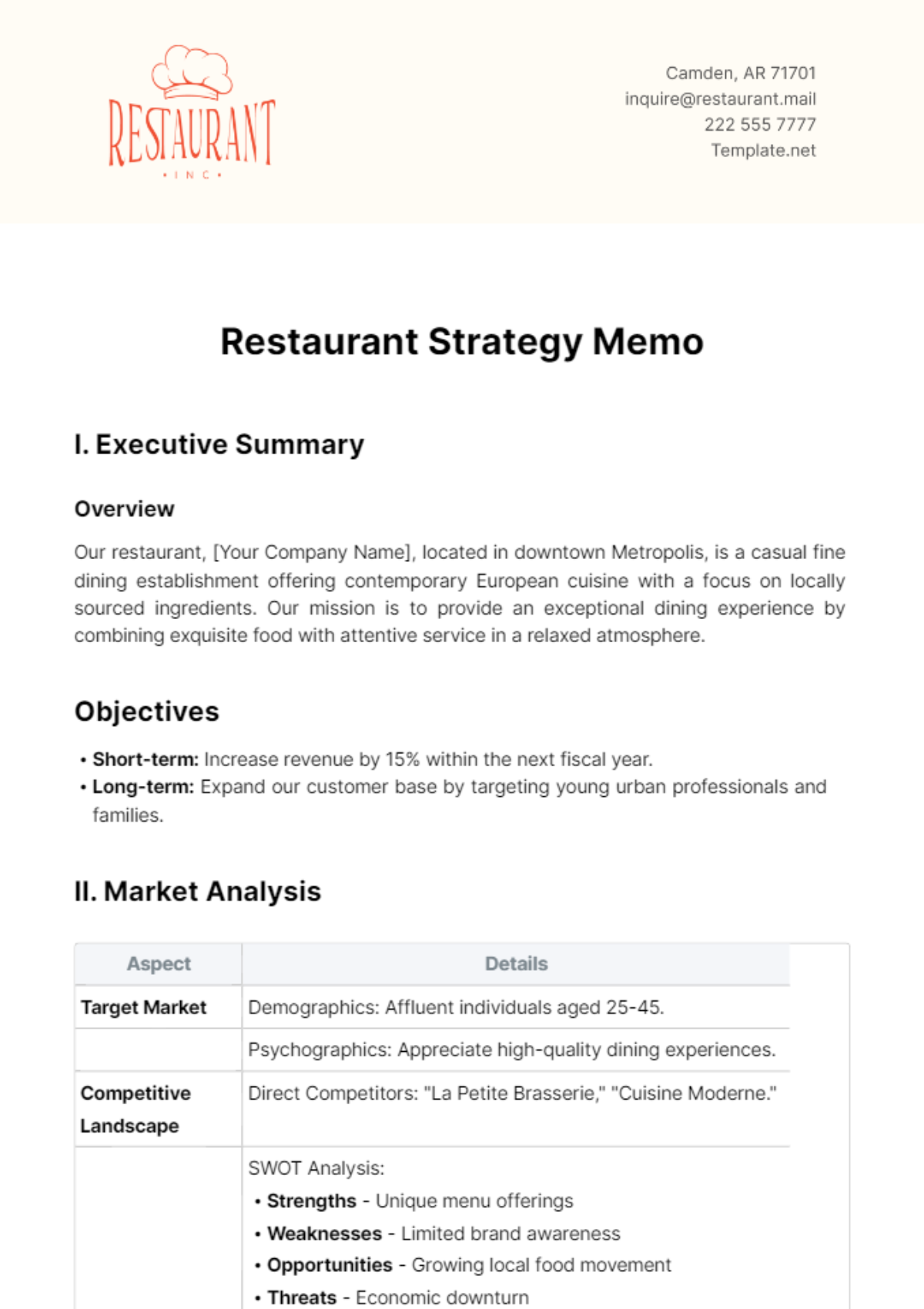
I. Executive Summary
Overview
Our restaurant, [Your Company Name], located in downtown Metropolis, is a casual fine dining establishment offering contemporary European cuisine with a focus on locally sourced ingredients. Our mission is to provide an exceptional dining experience by combining exquisite food with attentive service in a relaxed atmosphere.
Objectives
Short-term: Increase revenue by 15% within the next fiscal year.
Long-term: Expand our customer base by targeting young urban professionals and families.
II. Market Analysis
Aspect | Details |
|---|---|
Target Market | Demographics: Affluent individuals aged 25-45. |
Psychographics: Appreciate high-quality dining experiences. | |
Competitive Landscape | Direct Competitors: "La Petite Brasserie," "Cuisine Moderne." |
SWOT Analysis:
| |
Market Trends | Increasing demand for farm-to-table dining. |
Rising interest in sustainable and ethical food sourcing. |
III. Brand Positioning
Unique Selling Proposition (USP)
[Your Company Name] stands out for its innovative fusion of European flavors with locally sourced ingredients, offering a dining experience that celebrates both tradition and sustainability.
Brand Identity
Our brand is widely recognized and highly regarded for its embodiment of sophistication and culinary creativity, alongside its dedicated commitment to environmental stewardship.
IV. Menu Strategy
Menu Design
Our seasonal menu rotates quarterly, showcasing the freshest ingredients sourced from local farms and artisanal producers. Each dish is meticulously crafted to highlight the natural flavors and textures of the ingredients, ensuring a memorable culinary experience for our guests.
Alongside our à la carte offerings, we offer chef's tasting menus for guests seeking a curated dining experience, featuring a selection of our signature dishes paired with sommelier-recommended wines.
Pricing Strategy
Our pricing strategy reflects the premium quality of our ingredients and the culinary expertise behind each dish, positioning [Your Company Name] as a destination for discerning diners who value exceptional dining experiences. We conduct regular market analyses to ensure that our prices remain competitive while maintaining profitability and perceived value.
V. Marketing and Promotion
Marketing Plan
Our digital marketing efforts encompass targeted social media campaigns, influencer collaborations, and engaging content to increase brand visibility and drive foot traffic. We also leverage email marketing to communicate special promotions, events, and exclusive offers to our loyal customer base, fostering a sense of community and brand loyalty.
Community engagement initiatives include partnerships with local food festivals, charity events, and culinary workshops, positioning [Your Company Name] as an integral part of the vibrant food scene in our city while showcasing our commitment to supporting local artisans and sustainable practices.
VI. Operations Plan
Operational Procedures
Staffing levels are optimized to ensure smooth operations during peak hours while maintaining flexibility to adapt to fluctuations in customer traffic. Our customer service standards prioritize personalized attention, with regular staff training sessions focusing on hospitality, product knowledge, and conflict resolution.
To enhance efficiency, we are implementing cross-training programs to enable staff members to perform multiple roles within the restaurant, facilitating seamless transitions between front-of-house and back-of-house operations as needed.
Technology Integration
The upgrade to a cloud-based POS system streamlines order processing, inventory management, and reporting, providing real-time insights into sales performance and customer preferences. Integration with our reservation system allows for seamless table management, reducing wait times and maximizing seating capacity during peak hours.
In addition to enhancing the guest experience, our investment in technology enables data-driven decision-making, allowing us to identify trends, optimize inventory levels, and tailor marketing efforts to target specific customer segments more effectively.
VII. Financial Plan
Revenue Projections
Our revenue projections are based on historical sales data, market trends, and anticipated changes in customer behavior. We aim to achieve monthly revenue targets through a combination of increased guest counts, higher average check values, and strategic pricing adjustments.
Annual revenue growth is forecasted at 10%, driven by targeted marketing initiatives, menu innovations, and operational efficiencies that enhance profitability while maintaining the integrity of our brand and guest experience.
Cost Management
Fixed costs such as rent, utilities, and insurance are carefully monitored to identify cost-saving opportunities without compromising on quality or service standards. Variable costs including food, labor, and marketing expenses are managed through rigorous budgeting, vendor negotiations, and performance tracking against established benchmarks.
To optimize profitability, we conduct regular cost analyses to identify areas of overspending or inefficiency, implementing cost-saving measures where appropriate while reinvesting in initiatives that drive long-term growth and sustainability.
Profitability Plan
Our break-even analysis indicates that we aim to achieve profitability within the first six months of the fiscal year, allowing for reinvestment in key areas of the business and expansion opportunities. To maximize profitability, we focus on upselling and cross-selling opportunities, optimizing menu mix, and controlling costs through effective inventory management and waste reduction strategies.
Additionally, we prioritize staff training and development to enhance productivity and reduce turnover, ultimately improving the guest experience and driving repeat business, which is crucial for long-term profitability and sustainable growth.
VIII. Growth and Expansion
Expansion Plans
While our immediate focus is on maximizing the potential of our current location, we are actively exploring opportunities for expansion into neighboring markets where there is a demand for our concept. Our expansion strategy may include opening additional standalone locations, as well as exploring partnerships with hospitality groups or franchising opportunities.
Our long-term vision is to establish [Your Company Name] as a regional culinary destination, known for its innovative cuisine, exceptional service, and commitment to sustainability, with multiple locations serving diverse communities across the region.
Scalability
As we embark on our expansion journey, scalability is a key consideration to ensure that we can maintain the same level of quality, consistency, and guest experience across all locations. We are developing standardized operating procedures, training programs, and quality control measures to safeguard our brand integrity and reputation as we grow.
By leveraging technology, data analytics, and continuous feedback loops, we aim to adapt quickly to changing market dynamics, evolving consumer preferences, and operational challenges, ensuring that each new location reflects the essence of [Your Company Name] while catering to the unique needs of its local market.
IX. Risk Management
Risk Assessment
In addition to economic downturns and food safety incidents, other potential risks include regulatory changes, supply chain disruptions, and reputational damage from negative reviews or public relations crises. By conducting regular risk assessments and scenario planning exercises, we can proactively identify and mitigate potential risks before they escalate.
Market volatility, competitive pressures, and changing consumer preferences also pose risks to our business, highlighting the importance of agility, resilience, and strategic foresight in navigating uncertainty and maintaining a competitive edge in the marketplace.
Mitigation Strategies
To address economic volatility, we maintain a robust financial contingency plan, including cash reserves, lines of credit, and alternative revenue streams to cushion the impact of downturns or unforeseen expenses. Our comprehensive insurance coverage includes business interruption insurance, liability insurance, and product liability insurance to protect against potential liabilities and mitigate financial losses.
By diversifying our menu offerings, sourcing strategies, and revenue streams, we can reduce our exposure to supply chain disruptions, price fluctuations, and seasonality risks, ensuring continuity of operations and minimizing the impact on our guests and stakeholders.
X. Implementation Timeline
Action Plan
Q3: Launch digital marketing campaigns and loyalty program to coincide with peak dining season and capitalize on increased foot traffic.
Q4: Implement new menu items and upgrade POS system during traditionally slower months to minimize disruptions to operations and maximize guest satisfaction.
Milestones
Monthly revenue targets will be tracked and reviewed at regular intervals to assess progress against objectives and identify areas for improvement.
Quarterly performance reviews will evaluate key performance indicators, financial metrics, and operational benchmarks to ensure alignment with strategic goals and facilitate course corrections as needed.
- 100% Customizable, free editor
- Access 1 Million+ Templates, photo’s & graphics
- Download or share as a template
- Click and replace photos, graphics, text, backgrounds
- Resize, crop, AI write & more
- Access advanced editor
Improve your restaurant's strategic planning with the Restaurant Strategy Memo Template from Template.net. This editable and customizable template offers a comprehensive framework for crafting a winning strategy. Utilize the built-in AI Editor Tool to tailor the memo to your restaurant's unique needs and goals. Streamline your planning process and drive success with this invaluable resource.
